In the 'Oh, is that what that is?' category...
Diffraction, in the simplest description, is what happens when waves encounter objects. Their patterns tend to bend and distort, such as up top there, where plane waves become spherical waves by passing through a slit.
Light, as you might guess, experiences diffraction as well. Here's a schematic of light passing a sphere.
Irrelevant to today's topic, but those 'lines' extending to the right from the sphere are interference patterns. Where they are exceptionally bright, it is constructive interference, and the received light would actually be brighter than the original beam. The dark parts are destructive, and can actually result in no light being received.
And one day, when you're older, I'll tell you all about phase differences and explain that whole shebang.
But today isn't about that. Today is about a very familiar phenomenon to pretty much everyone: diffraction spikes. Take it away, NGC 6397!
Yeah, those things. Perhaps you'd like something more familiar, and we can accommodate.
You may have put two and two together by now. If you're gonna take a picture, you'll most likely need some lenses, maybe even a mirror. These items need to be held in place, with clips or rods or what-have-yeh. When the light hits these holders, it bends around them, distorting into these spikes once they get to the film/receiver.
One neat thing is that you can use these pictures to tell you how many holders, and the orientation of them.
Not everybody appreciates these spikes, so sometimes a person will close the aperture to exclude the outer circle, in some cases people even go so far as to manually remove the front part of a clip (if they had, for instance, a telescope they never intend on tipping forward).
Interesting to note: diffraction is dependent on the wavelength of the light, so that different colors of light will diffract at different angles. If you look back up at the nebula picture, you see an alternating blueish/reddish pattern. The interference pattern's intensity(number of photons) looks like this:
So that when you have a longer or shorter wavelength, the peaks shift outward or inward, respectively. If you do this with white light through a diffraction grating (a small sheet of material with hundreds or thousands of tiny slits to see through), you get a truly gorgeous result of light's wavelike behavior.
(That's a single wavelength on the top, with a full spectrum on the bottom)
You can see how the red light, with its longer wavelength, spreads out further and faster than the higher-energy, shorter-wavelength blue light.
Since I'm on the subject here, take an opportunity right now to curl up your forefinger so that only a little bit of light can get through it. Aim it between your eye and some white part of this screen, and adjust your 'aperture' as you peer through. You will notice little dark lines and dots showing up in the middle where nothing is touching. Those are spots of destructive interference, caused by your own hand!
And this is why it used to be so much easier to discover new laws of physics in your own basement.





No comments:
Post a Comment